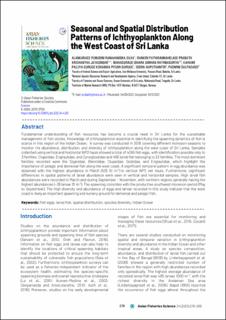| dc.contributor.author | Silva, Alankarage Pubudini Ranahansik | |
| dc.contributor.author | Jayasinghe, Rankiri Pathirannahelage P. K. | |
| dc.contributor.author | Rathnasuriya, Mahadurage I. G. | |
| dc.contributor.author | Guruge, Kahawe Palliya Guruge K. P. | |
| dc.contributor.author | Haputhantri, Sasira | |
| dc.contributor.author | Dalpadado, Padmini | |
| dc.date.accessioned | 2022-03-11T09:39:34Z | |
| dc.date.available | 2022-03-11T09:39:34Z | |
| dc.date.created | 2022-02-17T10:41:31Z | |
| dc.date.issued | 2021 | |
| dc.identifier.citation | Asian Fisheries Science. 2021, 34 278-289. | en_US |
| dc.identifier.issn | 0116-6514 | |
| dc.identifier.uri | https://hdl.handle.net/11250/2984537 | |
| dc.description.abstract | Fundamental understanding of fish resources has become a crucial need in Sri Lanka for the sustainable management of fish stocks. Knowledge of ichthyoplankton essential in identifying the spawning dynamics of fish is scarce in this region of the Indian Ocean. A survey was conducted in 2018 covering different monsoon seasons to monitor the abundance, distribution, and diversity of ichthyoplankton along the west coast of Sri Lanka. Samples collected using vertical and horizontal WP2 hauls showed a total of 4095 fish eggs, with identification possible only to 3 families: Clupeidae, Engraulidae, and Cynoglossidae and 465 larval fish belonging to 23 families. The most dominant families recorded were the Siganidae, Blenniidae, Clupeidae, Gobiidae, and Engraulidae, which highlight the importance of pelagic and demersal fish along the west coast. A significant temporal pattern in egg abundance was observed with the highest abundance in March (535 10 m-3 ) in vertical WP2 net hauls. Furthermore, significant differences in spatial patterns of larval abundance were seen in vertical and horizontal samples. High larval fish abundances were recorded in March and during September - November, with northern regions generally having the highest abundances (~36 larvae 10 m-3 ). The spawning coincides with the productive southwest monsoon period (May to September). The high diversity and abundance of eggs and larvae recorded in this study indicate that the west coast is likely an important spawning and nursery ground for demersal and pelagic fish. | en_US |
| dc.language.iso | eng | en_US |
| dc.title | Seasonal and Spatial Distribution Patterns of Ichthyoplankton Along the West Coast of Sri Lanka | en_US |
| dc.type | Peer reviewed | en_US |
| dc.type | Journal article | en_US |
| dc.description.version | publishedVersion | en_US |
| dc.source.pagenumber | 278-289 | en_US |
| dc.source.volume | 34 | en_US |
| dc.source.journal | Asian Fisheries Science | en_US |
| dc.identifier.doi | 10.33997/j.afs.2021.34.4.001 | |
| dc.identifier.cristin | 2002747 | |
| cristin.ispublished | true | |
| cristin.fulltext | original | |
| cristin.qualitycode | 1 | |
